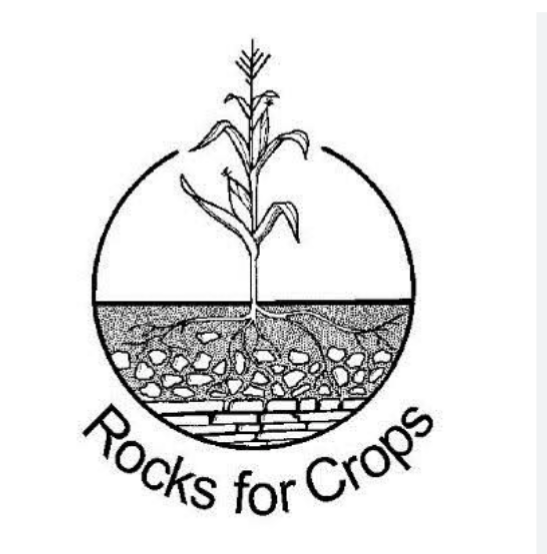
Agrogeology an inter-disciplinary science that involves various fields like geology, Agronomy, and soil science. It involves two main aspect.
1. The influence of parent materials on soil development, soil fertility and soil properties and 2. The application of rocks and minerals to enhance productivity of soil (Rocks for crops).
Agrogeology resources include rocks and minerals applied in agriculture. They have being existing in a wide varieties of environments since the pre-Cambrian till today. Agrominerals are naturally occurring geological materials in both unprocessed and processed forms that can be used in crop production systems to enhance soil productivity. These agrominerals also called rock fertilizers or petrofertilizers contain plant nutrients which are essential for plant growth and development. Such nutrients include nitrogen, phosphorus, potassium, calcium, magnesium, copper, manganese, iron, molybdenum, sulphur and boron. They are also utilized in solving problems of pH, texture and structure of rocks and fertility problems.
SOME DEFINATIONS OF AGROGEOLOGY
Agrogeology referred to as geology in service to agriculture is the scientific study of the origin, nature, composition, distribution and utilization of soils from a geological viewpoint. Geology is the scientific study of the Earth, and defines the soil as the uppermost geologic layer, or substratum, that supports plant life on the Earth’s land surface.
Straaten’s (2002) describes Agrogeology as the study of geological processes that influence the distribution and formation of soils and the application of geological materials in farming and forestry systems as means of maintaining and enhancing soil productivity for increased social, economic and environmental benefits.
Agrogeology is also defined as the study of the origins of minerals known as agrominerals and their applications.
Agrominerals are essential plant nutrients required for plant growth and development. These minerals are of importance in farming especially in soil fertility, fertilizer components and soil health. Some of these minerals and nutrients in them include: calcium from limestone and dolomite, potassium from feldspars, orthoclase and microcline, sulphur from pyrite marcasite, manganese from pyrolusite, molybdenum from molybdesite, zinc from sphalerite, base rich minerals like carbonates as source of magnesium and other nutrients, iron from siderite, copper from chalcopygrite and basic and ultra basic silicates rock etc.
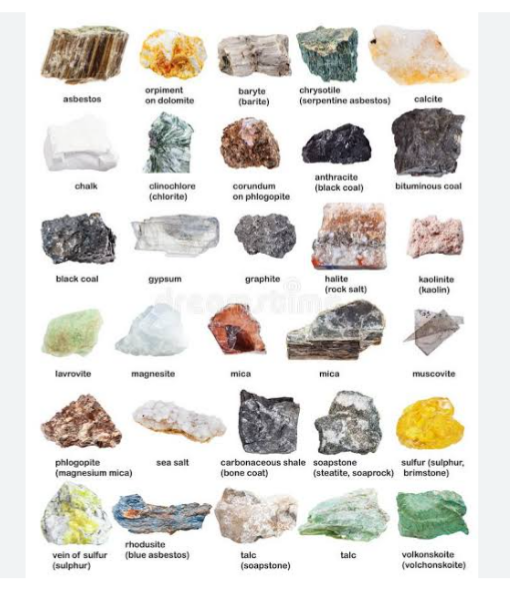
Agrogeology helps in the expansion of knowledge about the potential of rocks to restore soils productivity and soil health. It has the same goals as agroecology but maintains a specific focus on minerals that can maintain agricultural ecosystems. And also focuses on the understanding of how geological factors such as soil composition, bedrock characteristics, landforms, and hydrology influence agricultural productivity and land use.
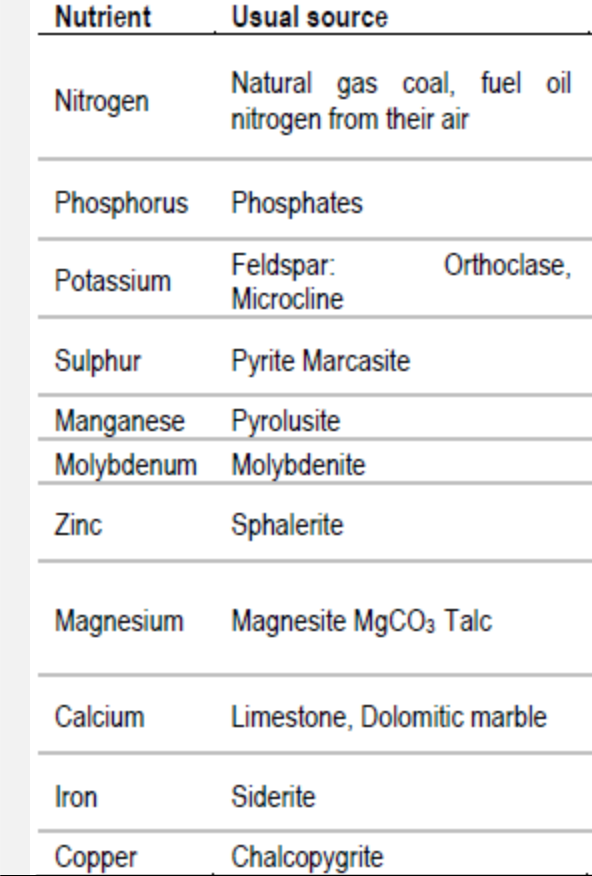
INFLUENCE OF GEOLOGICAL FACTORS ON AGRICULTURAL PRODUCTIVITY
1. SOIL COMPOSITION: The basic components of soil are minerals, organic matter, water and air. An ideal soil is composed of approximately 45% mineral, 5% organic matter, 20-30% water, and 20-30% air. These percentages are best for agricultural productivity. The solid phase of the soil include the mineral and organic matter, the liquid phase is water and the gaseous phase is the air.
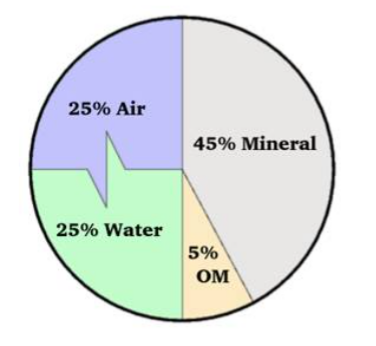
Soil composition is an important aspect of soil nutrient management. Soil minerals and organic matter assist the soil in holding and storing nutrients, soil water assist in dissolution of the readily provided nutrients for plant uptake. Soil air, assist many of the microorganisms living in the soil to carry out the biological processes that release additional nutrients into the soil.
For agrominerals and rocks to be used for crop cultivation, some physical and chemical manipulations would be needed. For example, utilization of phosphate mineral involves the process of preparation and separation. Agrominerals like limestone and dolomite can be added directly to the soil after physical processing like crushing and screening. Other nutrients can be released to soil during weathering.
2. SOIL FORMATION : Soil Formation is controlled by five distinct interconnected factors: parent material, climate, organisms, and time. These are referred to as soil formation factors. This brings about different characteristics in the different types of soils along side with the mineral constituents of rocks from which the soils are formed.
Agrogeologists do study the formation and properties of soils as a factor that influence agricultural productivity. They study the mineral composition, texture, structure, and fertility of rocks and soil in relation to crop cultivation. They investigate how geological processes like weathering, erosion, and sedimentation contribute to soil development and influence its suitability for different crops. The main chemical processes for soil formation are hydrolysis and dissolution.
3. BEDROCK CHARACTERISTICS: Bedrock underlies sand and other sediments on the ocean floor. It is consolidated rock, meaning it is solid and tightly bound. It is formed from the weathering of the three types of rocks ( that is, igneous, sedimentary and metamorphic rocks).
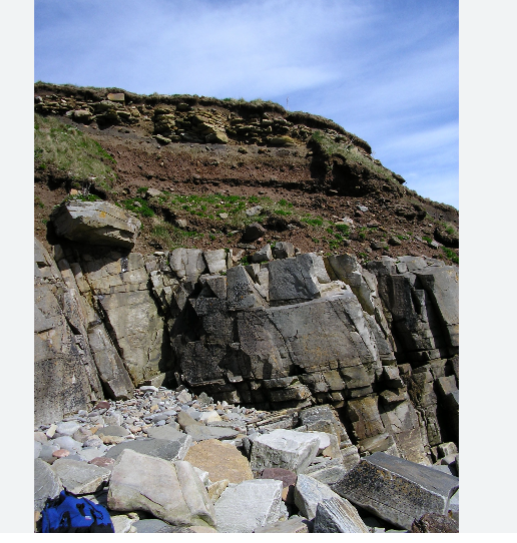
Bedrock are typically buried beneath soil and other broken or unconsolidated material (regolith). it is often refer to as the parent material (the source of rock and mineral fragments) for regolith and soil. Bedrock is also a source of nitrogen in Earth’s nitrogen cycle. During weathering of bedrock, large amounts of nitrogen are released that can be taken up by plants and other forms of life,. Bedrock is also composed of minerals deposited within the rock to which they are formed from. For example, sedimentary rocks is composed of limestone and dolomite which are sources of calcium. Therefore, the bedrock formed during the weathering of sedimentary rocks will also be composed of limestone and dolomite. A bedrock deposit that occurs at Earth’s surface is called an outcrop.
Bedrock is also composed of the characteristics of the rocks to which they are formed from. For example, Some bedrock deposits may be strong enough to resist the passage of glaciers and ice sheets over their exposed surfaces, others may be scratched or deeply striated. Erosion may also shape the bedrock of some rocks on the earth surface especially those formed close to mountains that serve as the source of glaciers into semicircular basins called cirques.
When water flows or ice come in contact with minerals in the bedrock, the chemical make-up of the minerals changes.
4. LANDFORMS: Landforms are natural features that shape the Earth’s surface. They are the result of geological processes occurring on the earth. These landforms encompasses various range of shapes, sizes, and formations. Landforms make it possible for human to have understanding of the dynamic processes that brings about the shape of our planet without any changes.
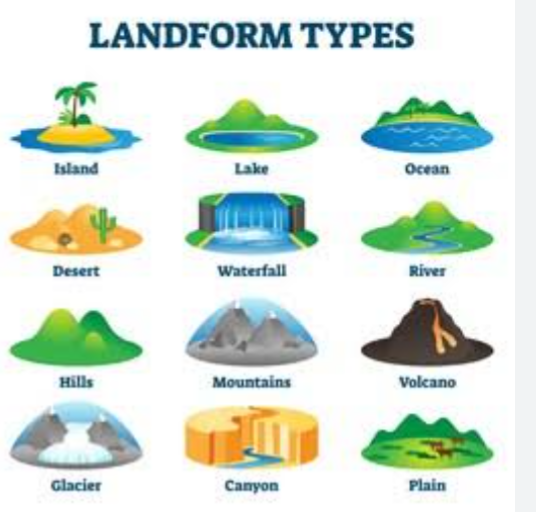
Various factors influences the development of landforms. Such factors including : geological, tectonic, climatic, time, weather, human, weathering and erosional processes. Land forms can be classified into various types based on their characteristics, geological processes involved in their formation, and their location.
Examples of landforms include mountains, Plateaus, rift valleys, rocks,Plains, Glacial Landforms, Deserts,Coastal Landforms, Karst Landscapes, water bodies and volcanic features.
Diverse landforms, such as mountains and floodplains, influences agricultural productivity through factors like rainfall patterns and soil fertility. For example, mountains can cause precipitation to occur on one side and prevent it and it’s effect on the other side. This is because more clouds are forming over those mountains and release their water into those areas which makes them wetter than other places around them. Also, it results in different levels of rainfall in different areas. Thus, determines the amount of water available to crops during crop production .
Diverse landforms can also impact agricultural productivity through their influence on soil fertility. Different types of landforms have different soil characteristics. For example, floodplains near rivers tend to have rich, fertile soil due to sediment deposition, while arid deserts have sandy and less fertile soil. These therefore makes soil fertility an important factor of landforms that influences the success of agricultural productivity.
Diverse landforms can also affect planting and transportation of farm produce. Planting on Hilly landforms can require extra effort in land preparation than flat surfaces. Farmers will have to construct barriers that will help prevent erosion along the slope. It can also affect what type of equipment and machinery will work best on a farm. For example, hillsides are often too steep for tractors so farmers must rely on their muscle power to get things done.
Transportation of farm produce can also be affected. Mountains or hills in an area may make movement difficult for farmers to get their farm produce and products to market because they would have to take a long time going up and down the hillsides with their produce.
5. HYDROLOGY: Hydrology is the study of the distribution and movement of water both on and below the Earth’s surface, as well as the impact of human activity on water availability and conditions.Water is essential for all life – for people, plants, and animals. How much water we have and how we use this water determines the productivity of our land. There is a limited amount of water on the Earth that flows in a cycle. This cycle is commonly known as the hydrological cycle. The hydrological cycle is also known as the water cycle which describes the material flow of water throughout the Earth. It comprises a series of steps that explain how water moves across the Earth and changes to various forms.
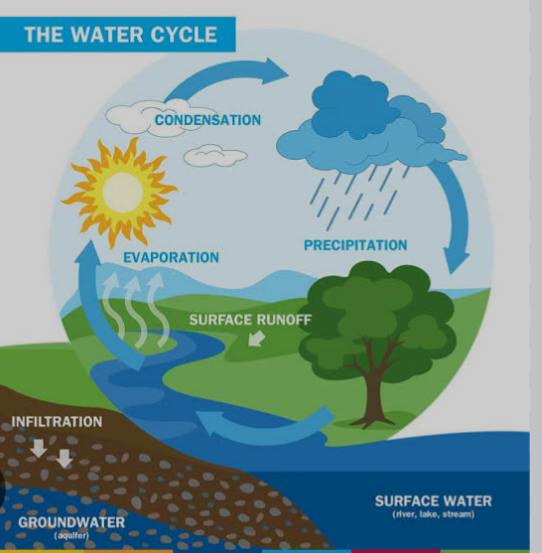
These steps result in continuous circulation of water between oceans, the atmosphere, and the land. The hydrological cycle involves natural phenomena that include precipitation, runoff, and storage before finally returning to the atmosphere.The precipitation can be in snow and rain, and the return of water to the atmosphere through transpiration and evaporation to keep the water on earth relatively constant.
Hydrology plays a crucial role in agricultural productivity. It helps in understanding the behavior of soil and water flows, which are essential for managing and protecting agricultural ecosystems . It also help in determining surface water quality. That is, how surface water acidity can be reduced so as to achieve overall health of agricultural systems. Overall, hydrology provides valuable insights into water use intensity, water flows, and the impact of management decisions on agricultural systems, enabling the development of sustainable and resource-efficient farming practices.
Some of the impact of hydrology on agriculture include: when precipitation occurs,
some portion of the precipitation will infiltrate into the soil. Thus, when the infiltration rate of the soil is less than the rainfall intensity, excessive precipitation becomes runoff, which causes erosion. Not all runoff reaches the ocean. Some evaporate while some are collected in different size impoundments. Some infiltrate into the soil, and the vegetation uses some portion. The water may become part of the plant processes and remain in it for extended periods, but it will eventually returns to the hydrological cycle.
The precipitation which infiltrates into the soil also takes different paths. Some fall on areas of deep soil and percolates deeply into the earth. Other infiltration may reach an impervious layer close to the surface and start moving horizontally at a rapid pace. The underground horizontal movement may end at some surface water or flow out of the ground as a spring or an artesian well. It may eventually land up in the sea and ocean. Once the water reaches the sea, the sun causes it to evaporate, and the water cycle begins again.
USES OF AGROGEOLOGICAL RESOURCES IN SOLVING AGRICULTURAL PROBLEMS
Agrogeological resources are utilized in solving problems of soil pH, texture, structure and fertility problems.
1. AGROGEOLOGICAL RESOURCES FOR SOLVING SOIL pH PROBLEMS Soils are produced by the physical, biological and chemical weathering of rocks. chemical weathering processes such as hydrolysis and dissolution result in production of bases, for example limestone which aid in neutralizing acids in aqueous phase of the soil. With this, positively charged cations are released into the soil which displace negatively charged anions and enter solutions where they are readily available to plant growth or loss to the system by leaching. This results in the decrease in soil pH and may, as well increase the availability of Aluminum and Manganese in the system which gives rise to toxicities.
In arid and semi-arid regions of the world where irrigation is employed as water source to crops, high alkalinity problems do occur. Weathering processes in such areas result in the release of basic agrominerals like Limestone, dolomite, base-rich materials (carbonatites) as well as basic and ultrabasic silicate rocks directly into the soils especially during physical weathering processes. These may therefore introduce toxicities of basic cations, rare earths and actinides, thus raising soil pH and deficiency of some essential elements like trace elements may occur.
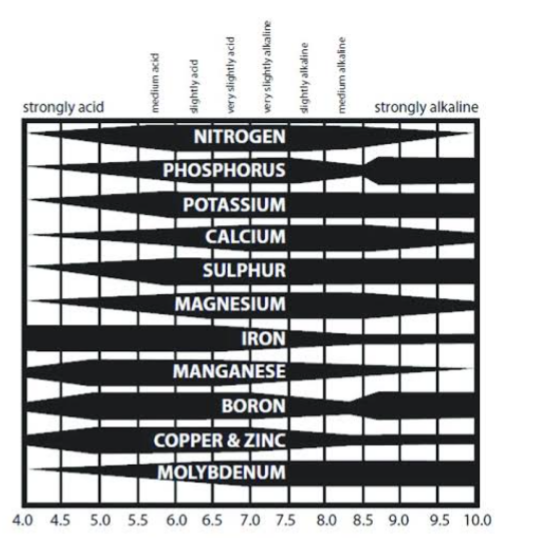
2. AGROGEOLOGICAL RESOURCES FOR SOLVING FERTILITY PROBLEMS Nutrients are lost by erosion, runoff, leaching, cropping and harvesting. When soil nutrients and organic matter are lost, poor soil health and infertile soil occurs. To overcome this problem, organic or inorganic fertilizers which are sources of plant nutrients will be needed. The major primary nutrients are nitrogen, phosphorus, and potassium. While the secondary nutrients include sulphur, calcium, magnesium, Others which are trace or minor nutrients are manganese, copper, zinc, manganese, iron, boron, and molybdenum.
These nutrients can be sourced from rock minerals such as rock phosphate, murate of potash, gypsum,
manganese, and zinc etc. Other nutrients can be sourced from the breakdown of the agrominerals to improve soil fertility. Most inorganic fertilizer nutrients are from the processing of agrominerals or petrofertilizers.
3. AGROGEOLOGICAL RESOURCES FOR SOLVING PHYSICAL PROBLEMS The physical soil properties include the soil texture and structure. The soil texture refers to the approximate measure of the particle size distribution or mechanical composition of the soil. While the structure refers to the degree and type of the aggregation of the soil. Problems that may occur from these two soil physical properties are leaching, compaction, runoff and erosion etc. Agrogeological resources and geological expertise may be used in tackling these problems. When soils are sandy, they are loose, high rate of leaching, runoff and water infiltration may occur which will reduce crop productivity. To improve such soil, addition of clays especially calcareous clays can be done. The principle is to modify the texture by adding material of contrasting grain size. Coarse materials like medium to coarse grained sand may be used to lighten heavy soils like clay. The main aim is to manage the available water, improve the soil nutrient status, improve water holding capacity of the soil etc. Also, a build-up of organic matter will improve soils structure while the use of rock mulches will minimize evaporation losses and prevent erosion.
